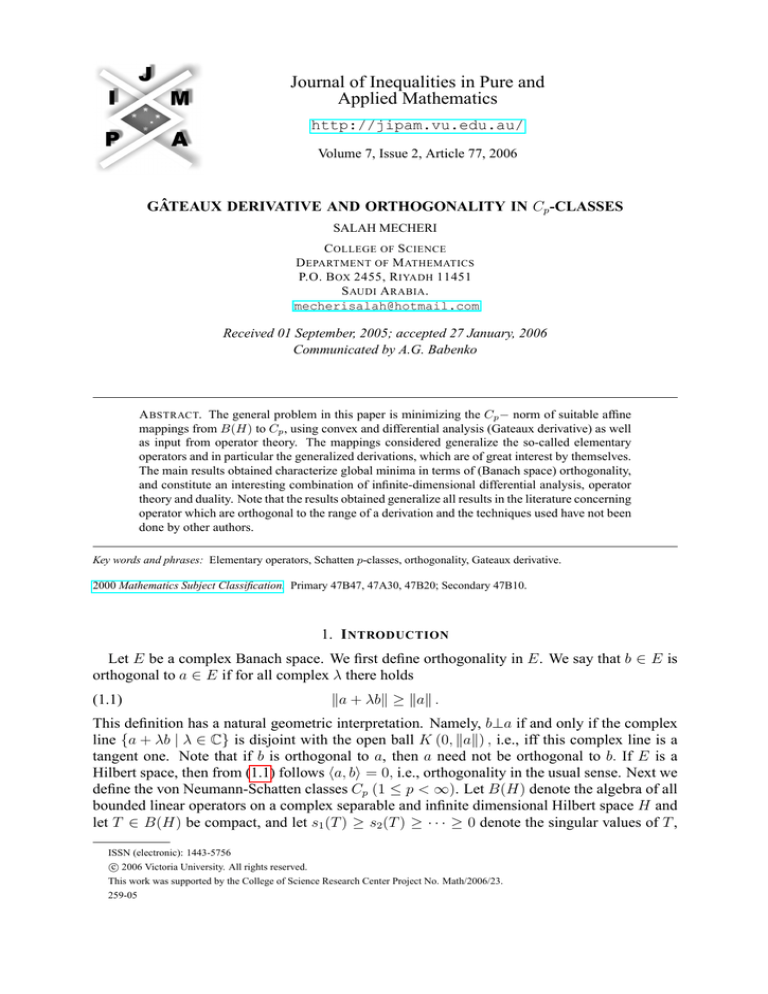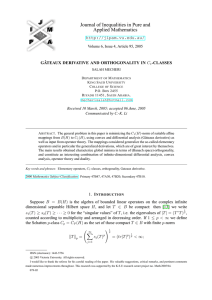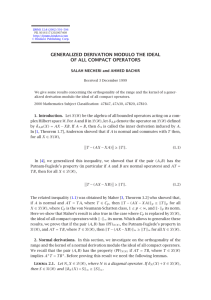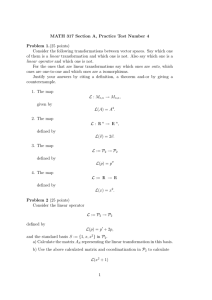
Journal of Inequalities in Pure and
Applied Mathematics
http://jipam.vu.edu.au/
Volume 7, Issue 2, Article 77, 2006
GÂTEAUX DERIVATIVE AND ORTHOGONALITY IN Cp -CLASSES
SALAH MECHERI
C OLLEGE OF S CIENCE
D EPARTMENT OF M ATHEMATICS
P.O. B OX 2455, R IYADH 11451
S AUDI A RABIA .
mecherisalah@hotmail.com
Received 01 September, 2005; accepted 27 January, 2006
Communicated by A.G. Babenko
A BSTRACT. The general problem in this paper is minimizing the Cp − norm of suitable affine
mappings from B(H) to Cp , using convex and differential analysis (Gateaux derivative) as well
as input from operator theory. The mappings considered generalize the so-called elementary
operators and in particular the generalized derivations, which are of great interest by themselves.
The main results obtained characterize global minima in terms of (Banach space) orthogonality,
and constitute an interesting combination of infinite-dimensional differential analysis, operator
theory and duality. Note that the results obtained generalize all results in the literature concerning
operator which are orthogonal to the range of a derivation and the techniques used have not been
done by other authors.
Key words and phrases: Elementary operators, Schatten p-classes, orthogonality, Gateaux derivative.
2000 Mathematics Subject Classification. Primary 47B47, 47A30, 47B20; Secondary 47B10.
1. I NTRODUCTION
Let E be a complex Banach space. We first define orthogonality in E. We say that b ∈ E is
orthogonal to a ∈ E if for all complex λ there holds
(1.1)
ka + λbk ≥ kak .
This definition has a natural geometric interpretation. Namely, b⊥a if and only if the complex
line {a + λb | λ ∈ C} is disjoint with the open ball K (0, kak) , i.e., iff this complex line is a
tangent one. Note that if b is orthogonal to a, then a need not be orthogonal to b. If E is a
Hilbert space, then from (1.1) follows ha, bi = 0, i.e., orthogonality in the usual sense. Next we
define the von Neumann-Schatten classes Cp (1 ≤ p < ∞). Let B(H) denote the algebra of all
bounded linear operators on a complex separable and infinite dimensional Hilbert space H and
let T ∈ B(H) be compact, and let s1 (T ) ≥ s2 (T ) ≥ · · · ≥ 0 denote the singular values of T ,
ISSN (electronic): 1443-5756
c 2006 Victoria University. All rights reserved.
This work was supported by the College of Science Research Center Project No. Math/2006/23.
259-05
2
S ALAH M ECHERI
1
i.e., the eigenvalues of |T | = (T ∗ T ) 2 arranged in their decreasing order. The operator T is said
to belong to the Schatten p-classes Cp if
"∞
# p1
X
1
kT kp =
si (T )p = [tr|T |p ] p < ∞, 1 ≤ p < ∞,
i=1
where tr denotes the trace functional. Hence C1 is the trace class, C2 is the Hilbert-Schmidt
class, and C∞ corresponds to the class of compact operators with
kT k∞ = s1 (T ) = sup kT f k
kf k=1
denoting the usual operator norm. For the general theory of the Schatten p-classes the reader
is referred to [16]. Recall (see [16]) that the norm k·k of the B−space V is said to be Gâteaux
differentiable at non-zero elements x ∈ V if there exists a unique support functional (in the dual
space V ∗ ) such that kDx k = 1 and Dx (x) = kxk, satisfying
kx + tyk − kxk
= Re Dx (y),
R3t→0
t
for all y ∈ V . Here R denotes the set of all reals and Re denotes the real part. The Gâteaux
differentiability of the norm at x implies that x is a smooth point of a sphere of radius kxk.
It is well known (see [6] and the references therein) that for 1 < p < ∞, Cp is a uniformly
convex Banach space. Therefore every non-zero T ∈ Cp is a smooth point and in this case the
support functional of T is given by
"
#
p−1
∗
|T | U X
,
(1.2)
DT (X) = tr
kT kp−1
p
lim
for all X ∈ Cp , where T = U |T | is the polar decomposition of T. The first result concerning
the orthogonality in a Banach space was given by Anderson [1] showing that if A is a normal
operator on a Hilbert space H, then AS = SA implies that for any bounded linear operator X
there holds
kS + AX − XAk ≥ kSk .
(1.3)
This means that the range of the derivation δA : B(H) → B(H) defined by δA (X) = AX −XA
is orthogonal to its kernel. This result has been generalized in two directions: by extending the
class of elementary mappings
n
X
EA,B : B(H) → B(H);
EA,B (X) =
Ai XBi − X
i=1
and
∼
∼
E A,B : B(H) → B(H);
E A,B (X) =
n
X
Ai XBi ,
i=1
where (A1 , A2 , . . . , An ) and (B1 , B2 , . . . , Bn ) are n− tuples of bounded operators on H, and
by extending the inequality (1.3) to Cp -classes with 1 < p < ∞ see [3], [6], [9]. The Gâteaux
derivative concept was used in [3, 5, 6, 7, 15] and [8], in order to characterize those operators which are orthogonal to the range of a derivation. The main purpose of this note is to
characterize the global minimum of the map
X 7→ kS + φ(X)kCp ,
φ is a linear map in B(H),
in Cp by using the Gateaux derivative. These results are then applied to characterize the operators S ∈ Cp which are orthogonal to the range of elementary operators. It is very interesting to
J. Inequal. Pure and Appl. Math., 7(2) Art. 77, 2006
http://jipam.vu.edu.au/
G ÂTEAUX D ERIVATIVE AND O RTHOGONALITY IN Cp - CLASSES
3
point out that our Theorem 2.3 and its Corollary 2.6 generalize Theorem 1 in [6] , Lemma 2 in
[3] and Theorem 2.1 in [18].
2. M AIN R ESULTS
Let φ : B(H) → B(H) be a linear map, that is, φ(αX + βY ) = αφ(X) + βφ(Y ), for all
α, β ∈ C and all X, Y ∈ B(H), and let S ∈ Cp (1 < p < ∞). Put
U = {X ∈ B(H) : φ(X) ∈ Cp } .
Let ψ : U → Cp be defined by
ψ(X) = S + φ(X).
+
Define the function Fψ : U → R by Fψ (X) = kψ(X)kCp . Now we are ready to prove our first
result in Cp -classes (1 < p < ∞). It gives a necessary and sufficient optimality condition for
minimizing Fψ .
Let X be a Banach space, φ a linear map X → X, and ψ(x) = φ(x) + s for some element
s ∈ X. Use the notation
1
Dx (y) = lim+ (kx + tyk − kxk).
t→0 t
It is obvious that Dx is sub-additive and Dx (y) ≤ kyk, also Dx (x) = kxk and Dx (−x) = −kxk.
Theorem 2.1. The map Fψ = kψ(x)k has a global minimum at x ∈ X if and only if
(2.1)
Dψ(x) (φ(y)) ≥ 0,
∀y ∈ X.
Proof. Necessity is immediate from ψ(x) + tφ(y) = ψ(x + ty). Sufficency: assume the stated
condition and choose y. Note that φ(y − x) = ψ(y) − ψ(x). For brevity we let Dψ(x) = L.
Then
kψ(x)k = −L(−ψ(x))
≤ −L(−ψ(x)) + L(ψ(y) − ψ(x)) by hypothesis
≤ L(ψ(y)) by sub-additivity
≤ kψ(y)k.
Theorem 2.2 ([7]). Let X, Y ∈ Cp . Then, there holds
DX (Y ) = pRe tr(|X|p−1 U ∗ Y ) ,
where X = U |X| is the polar decomposition of X.
The following corollary establishes a characterization of the Gateaux derivative of the norm
in Cp -classes (1 < p < ∞). Now we are going to characterize the global minimum of Fψ on
Cp (1 < p < ∞), when φ is a linear map satisfying the following useful condition:
(2.2)
tr(Xφ(Y )) = tr(φ∗ (X)Y ),
∀ X, Y ∈ Cp
where φ∗ is an appropriate conjugate of the linear map φ. We state some examples of φ and φ∗
which satisfy the above condition (2.2).
∼
(1) The elementary operator E A,B : I → I defined by
∼
E A,B (X) =
n
X
Ai XBi ,
i=1
J. Inequal. Pure and Appl. Math., 7(2) Art. 77, 2006
http://jipam.vu.edu.au/
4
S ALAH M ECHERI
where Ai , Bi ∈ B(H) (1 ≤ i ≤ n) and I is a separable ideal of compact operators
in B(H) associated with some unitarily invariant norm. It is easy to show that the
∗
conjugate operator EA,B
: I ∗ → I ∗ of EA,B has the form
∼∗
E A,B (X) =
n
X
Bi XAi ,
i=1
∼∗
∼
and that the operators E A,B and E A,B satisfy the condition (2.2).
∗
∗
∗
(2) Using the previous example we can check that the conjugate
Pn operator EA,B : I → I
of the elementary operator EA,B defined by EA,B (X) = i=1 Ai XBi −X, has the form
∗
(X)
EA,B
=
n
X
Bi XAi − X,
i=1
∗
and that the operators EA,B and EA,B
satisfy the condition (2.2).
Now, we are in position to prove the following theorem.
Theorem 2.3. Let V ∈ Cp , and let ψ(V ) have the polar decomposition ψ(V ) = U |ψ(V )|.
Then Fψ has a global minimum on Cp at V if and only if |ψ(V )|U ∗ ∈ ker φ∗ .
Proof. Assume that Fψ has a global minimum on Cp at V . Then
Dψ(V ) (φ(Y )) ≥ 0,
(2.3)
for all Y ∈ Cp . That is,
pRe tr(|ψ(V )|p−1 U ∗ φ(Y )) ≥ 0,
∀Y ∈ Cp .
This implies that
(2.4)
Re{tr(|ψ(V )|p−1 U ∗ φ(Y ))} ≥ 0,
∀Y ∈ Cp .
Let f ⊗ g, be the rank one operator defined by x 7→ hx, f i g where f, g are arbitrary vectors in
the Hilbert space H. Take Y = f ⊗ g, since the map φ satisfies (2.2) one has
tr(|ψ(V )|p−1 U ∗ φ(Y )) = tr(φ∗ (|ψ(V )|p−1 U ∗ )Y ).
Then (2.4) is equivalent to Re{tr(φ∗ (|ψ(V )|p−1 U ∗ )Y )} ≥ 0, for all Y ∈ Cp , or equivalently
Re φ∗ (|ψ(V )|p−1 U ∗ )g, f ≥ 0, ∀f, g ∈ H.
If we choose f = g such that kf k = 1, we get
(2.5)
Re φ∗ (|ψ(V )|p−1 U ∗ )f, f ≥ 0.
Note that the set
{ φ∗ (|ψ(V )|p−1 U ∗ )f, f : kf k = 1}
is the numerical range of φ∗ (|ψ(V )|p−1 U ∗ ) on U which is a convex set and its closure is a closed
convex set. By (2.5) it must contain one value of positive real part, under all rotation around the
origin, it must contain the origin, and we get a vector f ∈ H such that hφ∗ (|ψ(V )|p−1 U ∗ )f, f i <
where is positive. Since is arbitrary, we get hφ∗ (|ψ(V )|p−1 U ∗ )f, f i = 0. Thus
φ∗ (|ψ(V )|p−1 U ∗ ) = 0, i.e., |ψ(V )|p−1 U ∗ ∈ ker φ∗ .
Conversely, if ψ(V )|p−1 U ∗ ∈ ker φ∗ , then |ψ(V )|p−1 U ∗ ∈ ker φ∗ . It is easily seen (using the
same arguments above) that
Re tr(|ψ(V )|p−1 U ∗ φ(Y )) ≥ 0, ∀Y ∈ Cp .
By this we get (2.3).
J. Inequal. Pure and Appl. Math., 7(2) Art. 77, 2006
http://jipam.vu.edu.au/
G ÂTEAUX D ERIVATIVE AND O RTHOGONALITY IN Cp - CLASSES
5
We state our first corollary of Theorem 2.3. Let φ = δA,B , where δA,B : B(H) → B(H) is
the generalized derivation defined by δA,B (X) = AX − XB.
Corollary 2.4. Let V ∈ Cp , and let ψ(V ) have the polar decomposition ψ(V ) = U |ψ(V )|.
Then Fψ has a global minimum on Cp at V , if and only if |ψ(V )|p−1 U ∗ ∈ ker δB,A .
Proof. It is a direct consequence of Theorem 2.3.
This result may be reformulated in the following form where the global minimum V does not
appear. It characterizes the operators S in Cp which are orthogonal to the range of the derivation
δA,B .
Theorem 2.5. Let S ∈ Cp , and let ψ(S) have the polar decomposition ψ(S) = U |ψ(S)|. Then
kψ(X)kCp ≥ kψ(S)kCp ,
for all X ∈ Cp if and only if |ψ(S)|p−1 U ∗ ∈ ker δB,A .
As a corollary of this theorem we have
Corollary 2.6. Let S ∈ Cp ∩ ker δA,B have the polar decomposition S = U |S|. Then the two
following assertions are equivalent:
(1)
kS + (AX − XB)kCp ≥ kSkCp , for all X ∈ Cp .
(2) |S|p−1 U ∗ ∈ ker δB,A .
Remark 2.7. We point out that, thanks to our general results given previously with more
general linear maps φ, Theorem 2.5 and its Corollary 2.6 are true for the nuclear operator
∆A,B (X) = AXB − X and other more general classes of operators than δA,B such as the
∼
elementary operators EA,B (X) and EA,B (X).
The above corollary generalizes Theorem 1 in [6]and Lemma 2 in [3].
Now by using Theorem 2.5 , Corollary 2.6, Remark 2.7 and the following Lemma 2.8 and
Lemma 2.10 we obtain some interesting results see also ([3], [13]). Let S = U |S| be the polar
decomposition of S.
∗
(T ).
Lemma 2.8. Let A, B ∈ B(H) and T ∈ Cp such that ker δA,B (T ) ⊆ ker δA,B
p−1 ∗
p−1 ∗
If A |S| U = |S| U B, where p > 1 and S = U |S| is the polar decomposition of S,
then A |S| U ∗ = |S| U ∗ B.
Proof. If T = |S|p−1 , then
AT U ∗ = T U ∗ B.
(2.6)
We prove that
AT n U ∗ = T n U ∗ B,
(2.7)
for all n ≥ 1. If S = U |S|, then
ker U = ker |S| = ker |S|p−1 = ker T
and
(ker U )⊥ = (ker T )⊥ = R(T ).
This shows that the projection U ∗ U onto (ker T )⊥ satifies U ∗ U T = T and T U ∗ U T = T 2 . By
∗
taking the adjoints of (2.6) and since ker δA,B (T ) ⊆ ker δA,B
(T ), we get BU T = U T A and
AT 2 = AT U ∗ U T = T U ∗ BU T = T U ∗ U T A = T 2 A.
J. Inequal. Pure and Appl. Math., 7(2) Art. 77, 2006
http://jipam.vu.edu.au/
6
S ALAH M ECHERI
Since A commutes with the positive operator T 2 , A commutes with its square roots, that is,
AT = T A
(2.8)
By (2.6) and (2.8) we obtain (2.7). Let f (t) be the map defined on σ(T ) ⊂ R+ by f (t) =
1
t p−1 ; 1 < p < ∞. Since f is the uniform limit of a sequence (Pi ) of polynomials without
constant term (since f (0) = 0), it follows from (2.8) that APi (T )U ∗ = Pi (T )U ∗ B. Therefore
1
1
AT p−1 U ∗ = U ∗ T p−1 B.
Theorem 2.9. Let A, B be operators in B(H) such that ker δA,B ⊆ ker δA∗ ,B ∗ . Then T ∈
ker δA,B ∩ Cp , if and only if
kT + δA,B (X)kp ≥ kT kp ,
for all X ∈ Cp .
Proof. If T ∈ ker ∆A,B then by applying Theorem 3.4 in [9] it follows that
kT + δA,B (X)kp ≥ kT kp ,
for all X ∈ Cp . Conversely, if
kT + δA,B (X)kp ≥ kT kp ,
for all X ∈ Cp , then from Corollary 2.6
A |T | U ∗ = |S| U ∗ B.
Since ker δA,B ⊆ ker δA∗ ,B ∗ , B ∗ |T |p−1 U ∗ = |T |p−1 U ∗ A∗ . By taking adjoints we get AU |T |p−1
= U |T |p−1 B. From Lemma 2.8 it follows that AU |T | = U |T | B. i.e., T ∈ ker δA,B .
Note that the above theorem still holds if we consider ∆A,B instead of δA,B .
Let A = (A1 , A2 , . . . , An ), B = (B1 , B2 , . . . , Bn ) be n−tuples of operators in B(H). In the
following Theorem 2.12 we will characterize T ∈ Cp for 1 < p < ∞, which are orthogonal
to R(EA,B | Cp ) (the range of EA,B | Cp ) for a general pair of operators A, B. For this let
S = UP
|S| be the polar decomposition of S. We start by the following lemma or the case where
EC = Ci XCi − X which will be used in the proof of Theorem 2.12.
Let S = U |S| be the polar decomposition of S.
Lemma
2.10. Let
= (C1 , C2 , . . . , Cn ) be an n−tuple of operators in B(H) such that
PC
Pn
n
∗
∗
≤
1,
C
C
i=1 Ci Ci ≤ 1 and ker EC ⊆ ker EC ∗ . If
i=1 i i
n
X
Ci U |S|p−1 Ci = U |S|p−1 ,
i=1
where p > 1, then
n
X
Ci U |S| Ci = U |S| .
i=1
p−1
Proof. If T = |S|
, then
(2.9)
n
X
Ci U T Ci = U T.
i=1
We prove that
(2.10)
n
X
Ci U T n Ci = U T n ,
i=1
J. Inequal. Pure and Appl. Math., 7(2) Art. 77, 2006
http://jipam.vu.edu.au/
G ÂTEAUX D ERIVATIVE AND O RTHOGONALITY IN Cp - CLASSES
7
P
P
It is known that if ni=1 Ci Ci∗ ≤ 1, ni=1 Ci∗ Ci ≤ 1 and ker Ec ⊆ ker Ec∗ that the eigenspaces
corresponding to distinct non-zero eigenvalues of the compact positive operator |S|2 reduces
each Ci (see [4], Theorem 8), ([18], Lemma 2.3)). In particular, |S| commutes with Ci for all
1 ≤ i ≤ n. This implies also that |S|p−1 = T commutes with each Ci for all 1 ≤ i ≤ n. Hence
Ci |T | = |T | Ci and Ci T 2 = T 2 Ci .
Since Ci commutes with the positive operator T 2 , then Ci commutes with its square roots,
that is,
Ci T = T Ci .
(2.11)
By the same arguments used in the proof of Lemma 2.8 the proof of this lemma can be completed.
Theorem
2.11. Let
Pn
PnC =∗ (C1 , C2 , . . . , Cn ) be an n−tuple of operators in B(H) such that
∗
C
C
≤
1,
i
i
i=1
i=1 Ci Ci ≤ 1 and ker EC ⊆ ker EC ∗ then S ∈ ker EC ∩ Cp (1 < p < ∞),
if and only if,
kS + EC (X)kp ≥ kSkp ,
for all X ∈ Cp .
Proof. If S ∈ ker EC then from ([18], Theorem 2.4) it follows that
kS + EC (X)kp ≥ kSkp ,
for all X ∈ Cp . Conversely, if
kS + EC (X)kp ≥ kSkp ,
for all X ∈ Cp . then from Corollary 2.6 applied for the elementary operator E(X), we get
n
X
Ci |S|p−1 U ∗ Ci = |S|p−1 U ∗ .
i=1
Since ker EC ⊆ ker EC ∗ ,
n
X
Ci∗ |S|p−1 U ∗ Ci∗ = |S|p−1 U ∗ .
i=1
Taking the adjoint we get
Pn
i=1
Ci U |S|p−1 Ci = U |S|p−1 and from Lemma 2.10 it follows that
n
X
Ci U |S| Ci = U |S| ,
i=1
i.e., S ∈ ker EC .
Theorem 2.12. LetP
A = (A1 , A2 , . . .P
, An ), B = (B1 ,P
B2 , . . . , Bn ) be n−tuples
of operators
P
in B(H) such that ni=1 Ai A∗i ≤ 1, ni=1 A∗i Ai ≤ 1, ni=1 Bi Bi∗ ≤ 1, ni=1 Bi∗ Bi ≤ 1 and
ker EA,B ⊆ ker EA∗ ,B ∗ .
Then S ∈ ker EA,B ∩ Cp , if and only if,
kS + EA,B (X)kp ≥ kSkp
for all X ∈ Cp .
Proof. It suffices to take the Hilbert space H ⊕ H, and operators
Ai 0
0 T
0 X
Ci =
, S=
, X=
0 Bi
0 0
0 0
and apply Theorem 2.12.
J. Inequal. Pure and Appl. Math., 7(2) Art. 77, 2006
http://jipam.vu.edu.au/
8
S ALAH M ECHERI
R EFERENCES
[1] J. ANDERSON, On normal derivations, Proc. Amer. Math. Soc., 38(1) (1979), 129–135.
[2] G. BIRKHOFF, Orthogonality in linear metric spaces, Duke Math. J., 1 (1935), 169–172.
P
[3] B.P. DUGGAL, Range-kernel orthogonality of the elementary operators X → ni=1 Ai XBi − X,
Linear Algebra Appl., 337 (2001), 79–86.
[4] R.G. DOUGLAS, On the operator S ∗ XT = X and related topics, Acta. Sci. Math. (Szeged), 30
(1969), 19–32.
[5] D. KECKIC, Orthogonality of the range and the kernel of some elementary operators, Proc. Amer.
Math. Soc., 128(11) (2000), 3369–3377.
[6] F. KITTANEH, Operators that are orthogonal to the range of a derivation, J. Math. Anal. Appl., 203
(1996), 863–873.
[7] P.J. MAHER, Commutator Approximants, Proc. Amer. Math. Soc., 115 (1992), 995–1000.
[8] S. MECHERI, On minimizing kS − (AX − XB)kp , Serdica Math. J., 26(2) (2000), 119–126.
[9] S. MECHERI, On the orthogonality in von Neumann-Schatten classes, Int. Jour. Appl. Math., 8
(2002), 441–447.
[10] S. MECHERI, Another version of Maher’s inequality, Zeitschrift für Analysis und ihre Anwendungen, 23(2) (2004), 303–311
[11] S. MECHERI, Non normal derivations and orthogonality, Proc. Amer. Math. Soc., 133(3) (2005),
759–762.
P
[12] S. MECHERI, On the range and the kernel of the elementary operators Ai XBi − X, Acta Math.
Univ. Comenianae, LXXII(2) (2003), 191–196.
[13] S. MECHERI, Gateaux derivative and orthogonality in C-classes, J. Inequal. Pure and Appl. Math.,
6(4) (2005), Art. 95. [ONLINE: http://jipam.vu.edu.au/article.php?sid=568]
[14] S. MECHERI, Another version of Anderson’s inequality in the ideal of all compact operators, J.
Inequal. Pure and Appl. Math., 6(3) (2005), Art. 90. [ONLINE: http://jipam.vu.edu.au/
article.php?sid=563]
[15] S. MECHERI AND M. BOUNKHEL, Global minimum and orthogonality in C1 -classes, J. Math.
Anal. Appl., 287(1) (2003), 51–60.
[16] B. SIMON, Trace ideals and their applications, London Mathematical Society Lecture Notes Series,
35, Cambridge University Press, 1979.
[17] Y. TONG, Kernels of generalized derivations, Acta. Sci. Math., 54(102) (1990), 159–169.
[18] A. TURNSEK, Orthogonality in Cp classes, Monatsh. Math., 132(4) (2001), 349–354.
[19] T. YOSHINO, Remark on the generalized Putnam-Fuglede theorem, Proc. Amer. Math. Soc., 95(4)
(1985) 571–572.
[20] T. YOSHINO, Subnormal operators with a cyclic vector, Tohoku Math. J., 21 (1969), 47–55.
J. Inequal. Pure and Appl. Math., 7(2) Art. 77, 2006
http://jipam.vu.edu.au/







